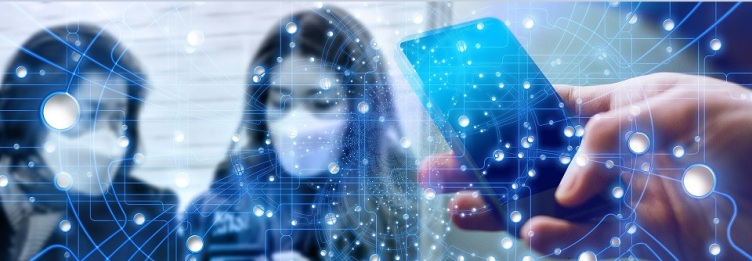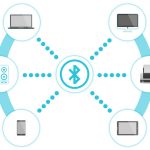How technology is used to combat Covid-19?

September 10, 2020
In new coronavirus worldwide expansion context by causing COVID-19 disease, it is important to analyze information and communication technologies role in public health, scientific, economic and social fields to help face instability situation generated by this pandemic. In this article we will introduce how technology has been used to combat Covid-19, in those countries where technology has been maximum exploited during this time of crisis. In which global industries, communities and citizens come together to find a solution; where human skills and technological reach have been found to generate common well-being. In this case, it is already possible to appreciate greatest impact of technological development thanks to the exponential growth of connectivity and access to information.
Aspects to consider to promote technological intervention
First step is to evaluate and discreet aspects to be considered to promote technological intervention in each niches that must be addressed immediately:
- Improving patient detection and diagnosis, tests application optimization and evaluation to help quickly identify positive cases.
- Stop spread of misinformation.
- Monitoring virus spread to allow a faster response to most affected areas.
- Data analysis acceleration and massive calculations in development of treatment and vaccines.
- Distribution and delivery of medical supplies to hospitals, as well as food to people who are in quarantine.
- Optimize teleworking tools.
- Offer video and conference calls options.
- Online education.
- Social media interactions.
- Kids entertainment applications.
How technology is used to combat Covid-19?
As a result of the pandemic, numerous initiatives have emerged to share resources and knowledge, such as open source data and designs, which help to find answers to some challenges and aspects to consider to promote technological intervention that rapid disease spread. From measure ability disease COVID-19evolution, or guarantee proper functioning and supply of materials in health centers, to alleviate the consequences of social distancing; with regard to social life, the need to recognize false information and prevent its spread on the internet is particularly relevant.
Big data
Big data has been used to offer open source data, maps and visualizations analysis on real time of the genome pathogens evolution such as coronavirus to understand their family tree and how it behaves over time. Advances in sequencers have allowed not only the cost of process to decrease enormously, but also accelerate it. This is of vital importance to design measures that can stop its spread.
These data are helping epidemiologists to understand its progress in different countries, as well as the possible mutations that may alter its nature. Thanks to maps of genomes evolution of this virus that have been shared among the scientific community, it has already been possible to corroborate there have been not notable changes in the virulence of this virus in its dispersal to new countries.
Summit, most powerful computer in globe developed by IBM, is being used in development treatment analysis thanks to its great data processing capacity have been possible to apply massive calculations and simulate 8,000 drug compounds in two days, 77 of which show some potential to prevent COVID-19 from infecting cells.
Machine learning
Artificial intelligence can be a powerful tool to make predictions about COVID-19 disease evolution or even in a possible treatment research. Biotechnology companies are using machine learning models to develop antibody-based therapies for patients who have recovered from this disease, massively testing immune cells for those that are capable of producing the antibodies that helped patients recover. Thanks to AI, they have already identified the sequence of 500 candidate antibodies that could become future therapies for this disease.
3D Printing
3D printing has been used to manufacture ventilators that allow assisted respiration to COVID-19 patients through open source design information shared by different platforms and communication channels enabled for this purpose. In this way, anyone who has these printers can collaborate by printing the necessary parts and thus replicating these automatic respirators. Main goal is to make them available to health services.
Drones
Nowadays, robotics is gradually being introduced in health and medical field, and with the coronavirus pandemic it has been exploited to maximum in different usages:
- Drones and robots deliver medical supplies to hospitals, as well as masks and food to people who are in quarantine in order to accelerate the distribution of these important supplies.
- Many airports, subways, schools and community centers have installed devices that allow to detect traveler corporal temperature by using a camera with thermal sensors to capture produced heat and generating an image representing a physical map. There are drones with thermal cameras too.
- Drones and robots are also used to disinfectant products in hotels, hospitals and other public buildings that disinfect rooms. In this way, need for health workers is met and contagion risk between patients and health workers is reduced.
- There are also drones and robots with speakers to spread awareness and prevention messages.
Chatbots
Multi-purpose chatbots have been implemented on different platforms. Main example for this is the World Health Organization WHO chatbot on WhatsApp whose main goal is to provide accurate information about new coronavirus and offer answers to common questions related to this disease. There are also other available bots whose function is to provide authorized information and remove from some different fake news social networks that they find.
Other technologies
There are many other technologies being used for different purposes to cover all aspects that must be considered in a global public health situation:
- Mobile applications and websites for telemedicine and virtual consultations to avoid collapse in hospitals.
- Medical innovation systems and cloud technology to diagnose patients and improve tests especially in the case of massive applications.
- Apps to monitor the spread of the virus to allow a faster response to the most affected areas.
- Apps for real-time monitoring based on surveillance tools developed from artificial intelligence algorithms that take data from news, forums, blogs and public health organizations to warn the population of potential outbreaks of diseases such as coronavirus.
- Systems to decongest telephone assistance lines where users who suspect they have the virus can perform a self-assessment of their health status based on their symptoms. Depending on their result, they will receive the pertinent instructions and recommendations for treatment.
- Tele Conferences and Video Calls to maintain ties with the outside world despite confinement. It has been seen how users have used them beyond their initial purpose and organize concerts, workshops and even protests by streaming.
- Remote work platforms and virtual classrooms through remote collaboration tools. There are limited-time free-to-use offers for small business cloud productivity suites, while a communication and video conferencing platform has expanded its free tier by allowing conversations to last more than 40 minutes. Teachers and students attend class from their homes, connected through the network, something that is possible thanks to the advancement of the cloud and easy and fast access to connectivity.
- Artificial Intelligence use for the Detection of fake news has been fundamental, massively analyzing articles and comments published on social networks from the origin of the disease to miracle cures and redirecting users to reliable WHOsources. Other tech organizations have focused on protecting their users from phishing, conspiracy theories, malware, and are constantly looking for new threats to combat them.
The role of technology
As COVID-19 outbreak was declared a global health emergency issue, nearly all business field have taken hands on technology in order to keep moving in spite of pandemic. With information mentioned above we had learned how technology have been used to combat Covid-19. Technology plays a fundamental role on supporting productive activities to continue to be carried out, and helping to create solutions for health, communication and other business areas.
Organizations, companies and people participation working in unique efforts to overcome the crisis situation and fight against COVID-19 give lessons of life, faith and hope in humanity and what it is still capable of achieving for the common good.
Keep safe and stay home!






